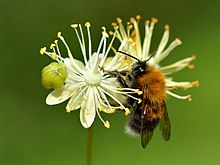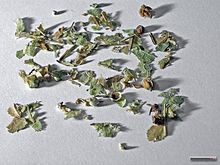Winter linden
| Winter linden | ||||||||||||
|---|---|---|---|---|---|---|---|---|---|---|---|---|

Winter linden ( Tilia cordata ), illustration |
||||||||||||
| Systematics | ||||||||||||
|
||||||||||||
| Scientific name | ||||||||||||
| Tilia cordata | ||||||||||||
| Mill. |
The small-leaved lime - even privet or scientifically Tilia cordata ( Latin for "Heartleaf Linde" or "heart [leaf] Linde") called - is a plant species from the genus of Linden ( Tilia ) in the subfamily of tilioideae ( Tilioideae ) within the family the mallow family ( Malvaceae ). The winter linden was the tree of the year 2016 in Germany.
features



The winter linden is a deciduous deciduous tree that can reach heights of up to 40 meters and is a maximum of 1000 years old. Its crown is arched and often slightly irregular. The bark of young trees is noticeably smooth and gray, later it becomes more brown-gray and is divided into various flat, longitudinal furrows and ridges. The branches are directed steeply upwards, only in older trees they lean partially downwards or to the side. The bark of the branches is brownish-red with lighter colored lenticels , hairless or almost bare. The egg-shaped, smooth, shiny red-brown buds have only two unevenly large bud scales.
The alternate leaves are petiolate. The outline of the leaf blade appears almost circular, it ends in a very short, slender, clearly recognizable point and is cut heart-shaped at the base and sometimes slightly oblique and about 6 centimeters long and 5 centimeters wide. The edge is sawed regularly and curved upwards. The upper side of the leaf is glossy dark green, the underside blue-green. There are rust-brown tufts of hair ( domatia ) in the axils of the leaf veins .
Four to twelve flowers are located on a hanging or protruding inflorescence . The sepals and petals are whitish. The flowering period extends from June to July.
The globular, initially furry, hairy capsule , often bald in late autumn, is 5 - 7 mm in size and has no protruding ribs. In contrast to the fruits of the summer linden tree, it is easy to crush.
The number of chromosomes is 2n = 82.
Distinction
The differences to the summer lime tree are fluid, since the two species are bastardizing ( Dutch lime tree ). The leaves of the winter linden are on average smaller than those of the summer linden. Their underside is blue-green (summer linden: light green; Dutch linden: pale green), with rust-red tufts of hair on the veins. In the summer linden, the veins are completely whitish or yellowish hairy on the underside. The ripe nuts of the winter linden tree are soft when crushed (hard in the summer linden tree). These properties are mixed in the case of Dutch linden trees.
ecology
The flowers are pre-male "nectar-bearing disc flowers" in hanging corymbs. They smell of honey . The nectar is deposited on the hollow sepals and is covered by hair. Most of the nectar is deposited in the evening and at night. The scar is slimy. The main visitors are bees and moths . Contrary to previous statements, the nectar is non-toxic (see Tilia tomentosa ). The winter linden is an important source of pollen for honey bees . The pollen can be carried by the wind and then u. a. Cause hay fever . A tree can have up to 60,000 flowers.
The unit of spread is the fruit cluster , the stalk of which has grown up to halfway with the tongue-shaped cover sheet (rekaulescence). The fruit cluster bears 5–7 one- to two-seeded nuts. It is spread as a rotary wing by the wind. The fruit ripens in September, with the fruit cluster remaining on the plant as a winter stand. In the next spring, germination takes place above ground (epigeic). But even fruits harvested green can germinate immediately. The cotyledons are exceptionally lobed hand-shaped.
Occurrence
The winter linden tree is widespread in Europe. However, their area extends beyond Europe to the Caucasus and western Siberia. It occurs mainly in the low mountain ranges, in the northern lowlands it is rarer. It can be found scattered in warm oak and hornbeam forests on fresh and mostly deep soils. It particularly likes to grow in the Galio-Carpinetum from the Carpinion association , but also occurs in societies of the Tilio-Acerion, Quercion roboris or Alno-Ulmion associations.
use
The winter linden is often planted as a street and park tree. In the apiary it is due to the very high sugar content of their nectar (30-74%) and its high sugar value (up to 3.57 mg of sugar / day per flower) an estimated costume . It is an excellent source of nectar for bees, honey yields of up to around 2.5 kg per tree and flowering season are possible. The "linden honey" is to be distinguished from the linden blossom honey; this also contains proportions attributable to honeydew .
Pharmacological use
The dried inflorescences ( Tiliae flos ) are used as medicinal drugs . Tea preparations made from the drug are used for colds and the associated urge to cough. While the cough-relieving effect can be explained by the 10% content of mucilage (predominantly arabinogalactans ), no specific ingredient has been found to explain its use as a sweat-inducing agent in febrile infections. In this case, the sweating effect is probably due to ingestion of the hot tea water.
Use of wood and bast
The wood of the winter linden does not differ from the wood of the summer linden and the Dutch linden . When using wood, no distinction is therefore made between these types. The main use of linden wood is in sculpture , carving and turning . Especially the famous late Gothic works , such as by Tilman Riemenschneider or Veit Stoss , were often made of limewood. In the meantime, the more easily obtainable wood of the Weymouths pine ( Pinus strobus ) is used for carving work.
Linden bast, that is, the sclerenchyma strands of the secondary phloem, was already used in the pile dwellings of the Stone Age to produce woven consumer goods. It is still used today as a gardener's bast and for handicrafts.
Well-known winter linden trees
- Barbarossa lime tree (no longer preserved) at Lorch Monastery (Baden-Württemberg), approx. 900, according to other information approx. 600 years old
- Tassilolinde on the monastery wall in Wessobrunn , approx. 600 years old (other information from 400 to 800 years)
- Court linden tree in front of St. Lucas Church in Scheeßel, approx. 600 years old
- Court linden tree on the Burgberg in Castell (Lower Franconia) (minimum estimate 500, maximum estimate 1,100 years)
- Schöppinger Linden in front of the chapel on the Schöppinger Berg or in front of the Brüningmühle ( Schöppingen ), both around 300 years old
- Winter linden tree in Glatt near Sulz am Neckar, around 400 years old
- Linden alley of the former Eythra Castle Park
- Thousand-year-old linden tree in Luckenwalde , probably around 750 years old
- Winter linden tree at the cemetery in Eschelbronn
- Old linden tree in Eschelbronn
- Bordesholmer Linde in Bordesholm
- Natural monument group of 3 winter linden trees , Brilon
- Winterlinde natural monument , Brilon
literature
- Gunter Steinbach (Ed.): Trees (Steinbach's nature guide). Mosaik Verlag GmbH, Munich 1996, ISBN 3-576-10554-9 .
- Ruprecht Düll , Herfried Kutzelnigg : Pocket dictionary of plants in Germany and neighboring countries. The most common Central European species in portrait. 7th, corrected and enlarged edition. Quelle & Meyer, Wiebelsheim 2011, ISBN 978-3-494-01424-1 .
- Ingrid and Peter Schönfelder : The new manual of medicinal plants , Franckh-Kosmos Verlagsgesellschaft, 2004, ISBN 3-440-09387-5 .
Web links
- Winter linden. In: FloraWeb.de.
- Distribution map for Germany. In: Floraweb .
- Tilia cordata Mill. In: Info Flora , the national data and information center for Swiss flora . Retrieved December 6, 2015.
- Distribution in the northern hemisphere according to Eric Hultén
- Thomas Meyer: Data sheet with identification key and photos at Flora-de: Flora von Deutschland (old name of the website: Flowers in Swabia )
- Winter linden on Baumkunde.de
- The winter linden. Tree of the year 2016 - information and pictures in the Sachsen-Anhalt-Journal 2016
Individual evidence
- ↑ a b Erich Oberdorfer : Plant-sociological excursion flora for Germany and neighboring areas . 8th edition. Verlag Eugen Ulmer, Stuttgart 2001, ISBN 3-8001-3131-5 . Page 655.
- ^ Tilia in the Germplasm Resources Information Network (GRIN), USDA , ARS , National Genetic Resources Program. National Germplasm Resources Laboratory, Beltsville, Maryland. Retrieved June 18, 2017.
- ↑ Helmut Horn, Cord Lüllmann: Das große Honigbuch , Kosmos, Stuttgart 3rd edition 2006, p. 30. ISBN 3-440-10838-4
- ↑ Josef Lipp et al .: Handbook of Apiculture - The Honey . 3., rework. Ed., Ulmer, Stuttgart 1994, ISBN 3-8001-7417-0 , p. 39
- ↑ D. Grosser, W. Teetz: Linde . In: Arbeitsgemeinschaft Holz eV (Ed.): Local timber (loose-leaf collection) . No. 17 . Information service wood, wood sales fund - sales promotion fund of the German forest and wood industry, 1998, ISSN 0446-2114 .





